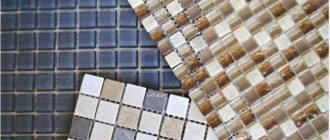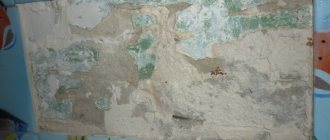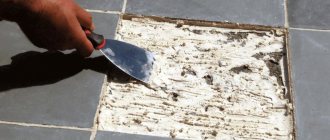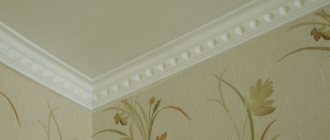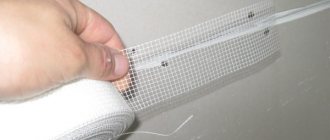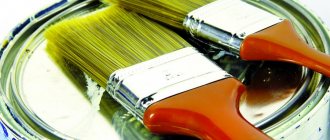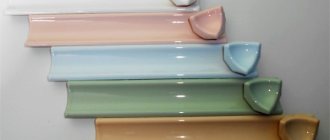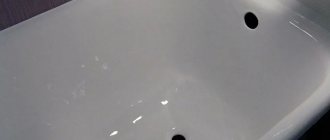Bathroom curb tape is the most affordable and fastest way to seal joints between plumbing fixtures and other surfaces. It has exceptional performance characteristics; the highest quality raw materials - elastomer - are used for its production. Produced not only by Russian, but also by foreign manufacturers. Butyl adhesive is applied along the entire length of the tape, which helps prevent peeling. The composition includes fungicidal substances that prevent the development of fungi and mold.
Installation of plumbing in the bathroom requires a large number of sealed connections.
In some cases it is impossible to avoid sealing the seam between the bathtub and the wall
If you don’t want to change your favorite tiles in the bathroom, but the gap between the wall and the bathroom is in the way, border tape will come to the rescue. In addition, it is impossible to install a sink or bathtub perfectly without a gap between the plumbing and the wall. This depends on the evenness of the walls and the ideal shape of the objects.
When installing a bathtub, a gap remains between its side and the tile lining or decorative plastic through which water can flow.
If a gap up to 2-3mm wide is formed, it is simply sealed with sealant. A much worse option is when the gap is 1 cm or more. In such cases, you cannot do without a special plinth (made of plastic or ceramic) or border tape.
Border tape for a bathtub is an effective way to eliminate puddles on the floor, wet walls, fungus and mold.
But if the gap is more than one centimeter, tape alone will not help. First, it will be necessary to seal it with tile adhesive, then treat it with a special solution, and only after complete drying can the tape be installed.
The material hermetically seals the joints and has good decorative properties.
Installing adhesive tape for the bathroom is a simple process; even a housewife can handle it. But to do this, you need to understand the intricacies of choosing a quality product and familiarize yourself with the installation rules.
Plumbing curb serves as a reliable sealing material that prevents water from entering the gaps.
Compound
The main task of a bathtub curb is to protect unprotected surfaces from water ingress, since high humidity contributes to the appearance of mold, mildew and insects. Therefore, in the production of border tape, only waterproof and water-repellent materials are used.
The vast majority of types of self-adhesive borders are made from synthetic polymers, most often polyethylene. In addition, the border tape contains a special glue that is resistant to moisture and temperature changes.
Many manufacturers of bathtub borders treat the product with a special composition that includes phytoncidal components. They repel insects, which can often be found in the bathroom.
Advantages of corner tape for the bathroom
Bathroom border tape, in addition to being the most affordable and convenient material, has a number of other advantages:
- It is very easy and quick to install; even a person completely uninitiated in construction can cope with this task.
- The tape is made of a fairly plastic material. Its flexibility and elasticity allow it to be applied not only to smooth rectangular joints, but also to curved and corner planes.
- It is a reliable sealing for joints in damp areas.
- It does not deform under loads, is resistant to mechanical damage and copes well with the effects of household chemicals.
- It contains an adhesive layer that provides reliable adhesion and a tight fit even when applied to glossy surfaces.
- It is distinguished by high quality at low cost.
However, with all the listed advantages, it has a number of disadvantages:
- The tape must be glued to a dry, clean, alcohol-free surface. Acetone has a detrimental effect on tape and acrylic baths.
- Interaction with acidic silicones has an extremely negative effect on its qualities. The tape may come off the surface or warp due to the silicone sealant.
- It is not durable. After 2-3 years it will need to be replaced with a new one.
- When purchasing, you should take into account the width of the joint between the bathtub and the wall, since the tape is sold in certain standard sizes. If the gap between the wall and the bathtub is more than 1 cm, you first need to fill it with putty and apply a primer.
The basis of border tapes is made up of synthetic components, which give the products the required elasticity, flexibility and water resistance.
Types of adhesive tape for the bathroom
If we talk about the varieties of border tape, then there is nothing special to brag about. As they say: products are produced strictly according to standards and do not differ in the variety of options and models.
The products are elastic, so they can be installed on joints of various shapes.
Profile
The name “scotch tape” speaks for itself. The profile is not distinguished by any crazy design ideas. This is an ordinary durable, elastic standard tape, most often white, very rarely found in others.
The borders do not deteriorate from exposure to temperature changes and are neutral to household chemicals - detergents and cleaners.
Size
Bathroom border tape is available in the following options:
- Width – 29mm, length – 3.2m;
- Width – 40mm, length – 3.2m;
- Width – 60mm, length – 3.2m.
It can be noted that the length is the same in all options. It is believed that it is quite enough to cover the bathroom on three sides. If you need to cover all four sides or if you have a bathroom model with non-standard shapes and curves, you will need to buy another tape.
Bathtub borders differ in size, decorative design and method of fixation.
Decor and color
In terms of color, everything is quite simple - if you are lucky, you can find a ribbon not only in white, but also in beige, pink, blue or greenish shades. Perhaps the color palette ends there. In terms of decor, it’s even sadder: no designs or patterns are expected - it’s just a plain ribbon of standard length and width.
The only minor inconvenience is that the service life of the tape is, on average, 3 years, after which the strip must be replaced.
Although, based on the main purpose of the material, it copes with its tasks perfectly. White tape is ideal for masking unsightly joints between a white bathtub and the wall, quickly and easily. The seam between the tile and the bathtub is smooth, neat and looks attractive from an aesthetic point of view.
After gluing the strip, a uniform and neat joint line is obtained, which gives the area with plumbing equipment a finished look and aesthetic appeal.
Polyurethane foam
Another option for sealing relatively wide seams is polyurethane foam. But not just any one. For extreme bathroom conditions, only a one-component polyurethane composition is suitable. It is strong, elastic and moisture-resistant enough to cope with the task.
The sealing job is simple enough that you can do it yourself. The sides of the bathtub are thoroughly cleaned and degreased, and then masking tape is glued around the perimeter, trying to lay it as close to the crack as possible. After this, the gap is filled with foam and left until it hardens completely. Finally, cut off the excess material with a sharp knife and remove the tape.
Is it possible to do without tape? You can, but then you will have to spend a lot of time and effort to scrape off the foam from the edges of the bathtub. This is quite difficult to do, and most likely you will have to resort to washes.
So, closing the gap with foam is quite easy. But you can’t leave it in its pure form. Firstly, this material does not look very good, and secondly, over time it will turn yellow and deteriorate. Needs additional finishing.
Installation technology
The tape should not be installed on a damp bathroom surface - it may not adhere well or peel off very quickly. Therefore, it must be mounted on a dry, clean wall degreased with acetone. The procedure is quite simple, a little similar to working with tape.
For ease of use, the tape is rolled up and, gradually removing the protective layer, applied to the seam.
How to choose quality colored border tape
To choose high-quality colored border tape, it is advisable to buy it in shopping centers, since it must be stored at a temperature not lower than +10 degrees, otherwise it will lose its adhesive properties. The storage period should not exceed 2 years. Do not expose the tape to open sunlight. Particular attention should be paid to the integrity of the packaging. Damaged or torn packaging may render the product unusable.
You can apply the border tape to the bathtub yourself. This does not require the skills of a professional repairman.
How to properly stick a border on a bathtub
In order to glue the border tape correctly, efficiently and without problems, it is necessary to follow a certain sequence and adhere to the rules.
Preparation
One of the main requirements for applying tape is the presence of a solid base. Therefore, if there is a gap between the bathtub and the wall of more than 1 cm, it must be sealed with tile adhesive or sealant.
Excess glue must be removed from the surface using a rubber spatula.
Important! The use of acidic silicone is strictly prohibited, as it can render the curb tape unusable. It is better to use acrylic and neutral silicone composition.
After the glue has dried, it is coated with a primer and dried again.
Remove dust from the seam with a dry, clean cloth and you can begin installing the adhesive tape.
If the seam has already been sealed previously, it is possible to save time. It is enough to clean it with fine sandpaper, then degrease it with alcohol (it is better not to use acetone, as it has a destructive effect on the adhesive layer of the tape), wait until it dries and you can stick the tape.
Most manufacturers produce white borders, since this material is universal.
Gluing tape
The process of installing a self-adhesive border for a bathroom can be divided into several successive stages:
- First you need to measure and cut the correct length of the tape. To do this, you need to take it and, applying it to the side of the bathtub, measure and cut off the required length with a sharp knife.
- Then about 10 cm of the protective film located on the side with the adhesive base is removed from the tape and you can begin gluing. As a rule, it is recommended to start gluing from the corner. It is necessary to press the tape well against the surface of the seam, especially tightly in the corner areas. So, gradually removing 10 cm of the protective film from the adhesive layer, cover the entire surface of the seam.
- After all the tape is pasted, you need to take a sharp knife and trim the corners. Moreover, this must be done with two halves at the same time, cutting them at an angle of 45 degrees in the direction from the corner to the bathtub.
- After the final stage of laying the corner tape, you must leave the coating alone for 24 hours; it is strictly forbidden for water to enter this area.
- If suddenly after a day in some places the summer still does not adhere well, you can glue it with liquid nails and wait until it dries again.
Self-adhesive bathtub curb tape has an important and useful feature - an adhesive composition is applied to the back of the material.
After a day, you can use the shower quite confidently and not worry about water running under the bathtub.
Useful tips
Applying border tape is very simple. You can cope with this even without repair skills, but you still need to take into account some tips:
- to clean the surface from dust and dirt, you can use any cleaning products or soda and, of course, water;
- You can use gasoline or alcohol as a degreaser;
- the tape must be cut so that its length is approximately 2.5 cm longer than the length of the surface to be pasted;
- if the tape is not cut into pieces, but glued in one piece, small cuts must be made in the corners;
- if several pieces of material are used, it is advisable to glue them overlapping in the corners;
- It is necessary to glue the tape, pressing each part of it to the surface for about 20 seconds.
As you can see, there is nothing complicated in the process of installing curb tape. And for even greater self-confidence, you can also watch the presented video.
Source

